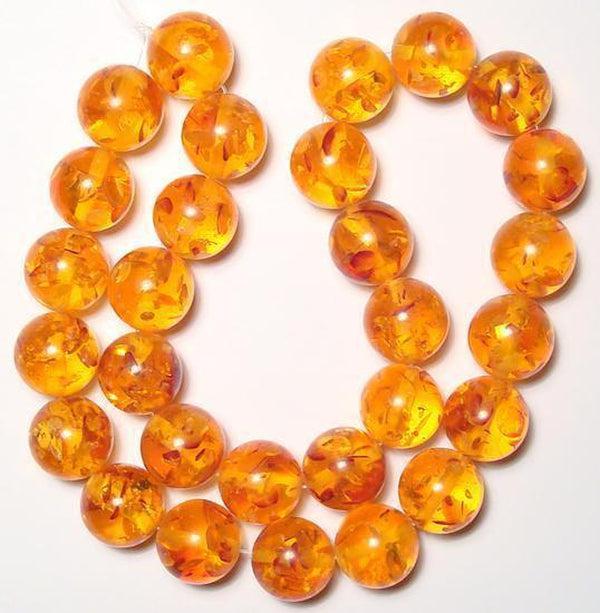How to test for fake Baltic amber. How to tell if my amber jewellery is real?

How to test for fake Baltic amber
Currently, the marketplace is flooded with fake amber especially those with inclusions. In this blog post, we will describe the most prevalent fake amber types. There are a number of tests or methods to determine fake Baltic amber from natural Amber.
First of all, what is Baltic amber?
Baltic amber is a type of amber. Amber is not a rock or gemstone. Amber is actually fossilised tree resin and can be found in many regions throughout the world. Baltic amber is specifically amber from the area near the Baltic Sea, including areas in Poland, Lithuania and Latvia, just to name a few. Baltic amber contains an acid called succinic acid. Succinic acid is an alkalizing acid which is actually already present in your body in small amounts.
Most commonly amber is associated with its well know yellow-orange-brown hues. However, there are numerous different shades, from a brittle white color through to citrus yellow, brown and even black. Other uncommon colours include red, green and even blue - a rare Dominican amber however this is not a Baltic Amber.
Fake amber is often made from the following items. They resemble natural amber, but they are not real. Copal, Glass, Phenolic resins, Celluloid, and plastic.
Copal (young amber) is sold as Baltic amber, but in fact, this is very young tree resin (1000- 1million years old). Natural inclusions are possible in Copal, but usually, they are fake. Insects are inserted into them that are too big and too perfect. Copal melts at rather a low temperature (lower than 150C) and tends to melt rather than burn. After heating, it diffuses the smell of burning resins.
Glass. It is easy to distinguish glass from amber: it is more solid; it cannot be scratched by metal. Glass is fireproof. It is also cold to the touch.
Phenolic Resin: this material is found in artificial amber beads. These amber beads perfectly shaped (oval, faceted), the colour is very similar to real amber (dark red, cloudy yellow). After heating, it does not diffuse the smell of pine-tree resins, which is characteristic for Baltic amber.
Cellulose nitrate is usually yellow and cloudy. Visually it is difficult to distinguish it from amber. Celluloid is more solid and not as combustible. After heating, it diffuses the smell of burnt plastic.
Plastic (polyester, polystyrene) are used to produce artificial amber and inclusions. The beads are too perfect and too round and do not contain any of the characteristics of natural amber beads. All colours are uniform too. After heating, it diffuses the smell of burnt plastic.
Tests to check if your amber is genuine
Smell Test
Smell tests are the most effective because natural amber has a specific smell, which is difficult to obtain when producing fakes. After heating real Baltic amber diffuses the specific delicate fragrance of pine-tree resins other materials diffuse the smell of burnt plastic. I often refer to the smell as ‘salty trees’.
Rub Test
It is possible to heat real amber by rubbing until it releases the smell of pine- tree resins. This needs a very strong hand, as it is rather difficult to heat amber (especially when polished) to the necessary temperature. It works best if rubbed in the palm of the hand.
Acetone Test
Take a few drops of acetone (fingernail polish remover) or alcohol and drip it over the surface of your piece. If the surface becomes tacky, or the fluid takes on the honey golden colour of the substance, you can bet it's not amber. Amber is not harmed and will not dissolve under these solvents.
Salt Water Test
This test is extremely easy and effective. All you have to do is mix two cups of warm water with a quarter cup of salt in a bowl, then stir the mixture until the salt has completely dissolved. Once you have done this, place the piece of amber in the solution. If the piece of amber floats then it is indeed authentic amber.
UV Test
If you have spent a lot of money on buying amber, this is the best test for you. For this, you will need a UV lamp. Amber has a kind of blue or green colour when placed under a UV light. Therefore, if your amber piece shows up as another colour when placed under the light, it is not true amber.
Hot Needle Test
The most effective test is the hot needle test. Stick a heated needle into discreet place in the Amber (a hole of a drilled bead, etc.). If you smell definite pine-tree resins it means it is real amber.
IR-spectroscopy
This the most effective scientific method for identifying resins. Baltic amber could be characterised by IR-spectrum segment called the Baltic amber shoulder. Love Amber x has a copy of the IR tests direct from our manufacturer.
The biggest indicator of authenticity is the price. If the amber you are purchasing is dirt cheap, it is likely that it is a fake. We have a saying. Buy cheap, buy twice…. Buyer beware.
Love Amber x